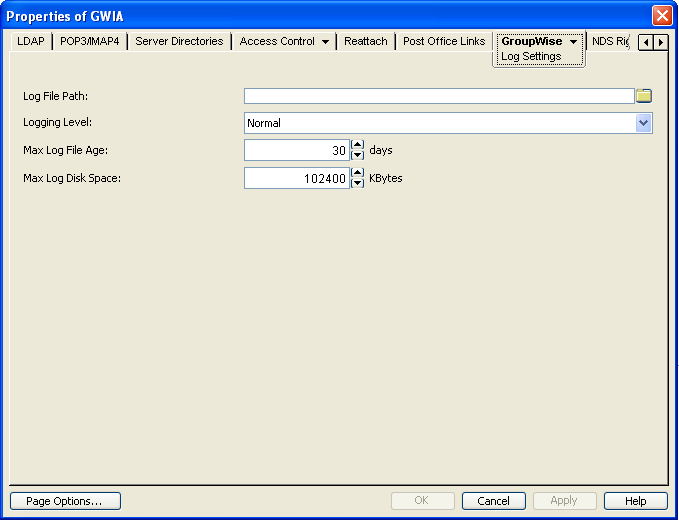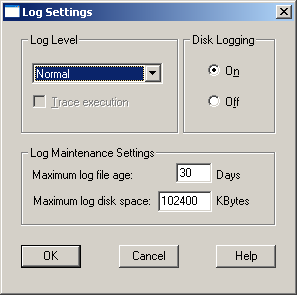56.6 Using GWIA Log Files
You can use the GWIA logging options to help you monitor its operation. By default, the GWIA logs information to its server console, Web console, and to a log file on disk. You can control the following logging features:
-
The type of information to log.
-
Disabling disk logging (Windows GWIA only).
-
How long to retain log files.
-
The maximum amount of disk space to use for log files.
-
Where to store log files.
You can control logging through ConsoleOne, GWIA startup switches, and the GWIA console. The following table shows which logging options you can control from each location.
|
ConsoleOne |
Startup Switches |
Linux Console |
Windows Console |
|---|---|---|---|---|
|
Logging Level |
Yes |
Yes |
Yes |
Yes |
|
Disk Logging |
No |
No |
Yes |
Yes |
|
Maximum Log File Age |
Yes |
Yes |
Yes |
Yes |
|
Maximum Disk Space |
Yes |
Yes |
Yes |
Yes |
|
Log File Location |
Yes |
Yes |
No |
No |
The log settings in ConsoleOne are used as the default settings. Startup switches override the ConsoleOne log settings, and console settings override startup switches.
56.6.1 Locating GWIA Log Files
The default location of the GWIA log files varies by platform:
|
Windows: |
|
|
Linux: |
You can change the location where the GWIA creates its log files in ConsoleOne, the GWIA configuration file (gwia.cfg), and the GWIA server console.
56.6.2 Modifying Log Settings in ConsoleOne
Through ConsoleOne, you can configure the following log settings:
-
Log file location
-
Logging level (applies to both console logging and disk logging)
-
Maximum age for log files
-
Maximum disk spaced used for log files
The ConsoleOne settings are the default settings. The GWIA uses these settings unless you override them with startup switches in the gwia.cfg startup file or at the server console.
To configure the default log settings in ConsoleOne:
-
Right-click the GWIA object, then click .
-
Click to display the Log Settings page.

-
Modify any of the following properties:
Log File Path: The GWIA creates a new log file each day and each time it is started. The log file is named mmddgwia.nnn, where mm is the month, dd is the day, and nnn is a sequenced number (001 for the first log file of the day, 002 for the second, and so on). The default location of the log files depends on the platform where the GWIA is running.
Windows:
Linux:
If you want to specify a different location, enter the directory path or browse to and select the directory.
Logging Level: There are four logging levels:
-
Off: Disables the logging function.
-
Normal: Displays warnings and error messages. This is the preferred logging level.
-
Verbose: Displays information about traffic, including non-delivery reports, in addition to warnings and error messages. Information includes the file name, path, message ID, and size of the message being processed; the IP address of any inbound SMTP connections; the GWIA-specific MSG number; and SMTP connection messages such as “Connect to novell.com” and “Accepted connection from 172.16.5.18 novell.com”.
-
Diagnostic: Displays detailed function calls made by the GWIA. This level is not useful for most troubleshooting. Verbose is better for standard troubleshooting.
The Verbose and Diagnostic logging levels do not degrade GWIA performance, but log files saved to disk consume more disk space when Verbose or Diagnostic logging is in use.
Max Log File Age: Specify the number of days you want the GWIA to retain old log files. The GWIA retains the log file for the specified number of days unless the maximum disk space for the log files is exceeded. The default age is 30 days.
Max Log Disk Space: Specify the maximum amount of disk space you want to use for log files. If the disk space limit is exceeded, the GWIA deletes log files, beginning with the oldest file, until the limit is no longer exceeded. The default disk space is 102400 KB (100 MB).
-
-
Click to save the log settings.
56.6.3 Modifying Log Settings through Startup Switches
You can use startup switches to override any log settings you configured in ConsoleOne. as described in Section 56.6.2, Modifying Log Settings in ConsoleOne. Edit the gwia.cfg file to change switch settings, as described in Section 59.1.2, Modifying the gwia.cfg File.
For information about the startup switches that can be used to modify log settings, see Section 59.12, Log File Switches.
56.6.4 Modifying Log Settings through the GWIA Server Console
You can use the Windows GWIA console to override the following log settings for the current sessions:
-
Disk logging on/off
-
Log file location
-
Logging level (applies to both console logging and disk logging)
-
Maximum age for log files
-
Maximum disk spaced used for log files
Changes you make to the log settings at the console apply only to the current session. When you restart the GWIA, the log level is reset to the level specified in ConsoleOne or the startup switches. See Section 56.6.2, Modifying Log Settings in ConsoleOne and Section 56.6.3, Modifying Log Settings through Startup Switches.
To modify the log settings:
-
In the Windows GWIA console, click to display the Log Settings dialog box.

-
Change the desired settings:
Log Level: Select to display warnings and error messages; this is the preferred logging level. Select to display information about traffic, including non-delivery reports, in addition to warnings and error messages. Information includes the file name, path, message ID, and size of the message being processed; the IP address of any inbound SMTP connections; the GWIA-specific MSG number; and SMTP connection messages such as “Connect to novell.com” and “Accepted connection from 172.16.5.18 novell.com”. Select to display a detailed trace of gateway messages, errors, and operations that can be useful for troubleshooting.
Disk Logging: Select or to enable or disable logging of information to log files.
Maximum Log File Age: Specify the number of days you want the GWIA to retain old log files. The GWIA retains the log file for the specified number of days unless the maximum disk space for the log files is exceeded. The default age is 30 days.
Maximum Log Disk Space: Specify the maximum amount of disk space you want to use for log files. If the disk space limit is exceeded, the GWIA deletes log files, beginning with the oldest file, until the limit is no longer exceeded. The default disk space is 102400 KB (100 MB).
56.6.5 Viewing Log Files
You can view the log file for the current session, or you can view archived log files. The current log file is viewable through the GWIA console, as described in Section 56.1, Using the GWIA Server Console, or in the GWIA Web console, as described in Section 56.2, Using the GWIA Web Console. Archived files are viewable through the consoles or an ASCII text editor.
Current Log File
The current log file is displayed in the Logging window of the GWIA console, with only the most current operations visible. The log file is complete, and includes the gateway startup and configuration information and ongoing operations logged by time, including the shutdown operation. You can browse the file from top to bottom or perform a search for any text string you want. You can also view the current log file from the GWIA Web console.
Archived Log Files
The GWIA creates a new log file every day at midnight or every time it restarts. Older log files are not deleted for at least one day unless you have not allowed sufficient disk space for them to be archived.
Log files are named according to the date they were created. If the GWIA was restarted during the day, the file extension indicates which session is logged (for example 0518log.003 indicates the third session logged for May 18).
Archived log files are saved in ASCII. You can use any text editor to open a file or to print it. You can also view the log files from the GWIA console or the GWIA Web console.